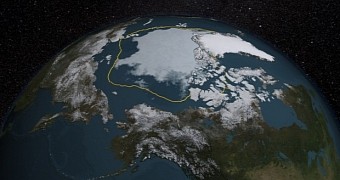A new report put together by NASA scientists and fellow researchers at the University of Colorado Boulder shows that, this year, summer ice cover in the Arctic shrunk just enough to reach its fourth lowest extent on record.
More precisely, the research team say that, on September 11, the Arctic's sea ice cover spanned across a total of 1.70 million square miles (4.41 million square kilometers), a 699,000 square miles (1.81 million square kilometers) drop when compared to the 1981-2010 average.
Scientists warn that, by the time this month is over, sea ice cover in this corner of the world could shrink even further. This is because, in this day and age, the Arctic is not as resilient to environmental quirks as it once was.
“The ice cover becomes less and less resilient, and it doesn’t take as much to melt it as it used to. The sea ice cap, which used to be a solid sheet of ice, now is fragmented into smaller floes that are more exposed to warm ocean waters.”
“In the past, Arctic sea ice was like a fortress. The ocean could only attack it from the sides. Now it’s like the invaders have tunneled in from underneath and the ice pack melts from within,” researcher Walt Meier said in a statement.
The Arctic is changing, there is no going about it
True, it is perfectly normal for the sea ice cap in the Arctic to grow or shrink with the seasons. The thing is that, since the late 1970s, its minimum extent during the summer months has been getting smaller and smaller.
Scientists think this is because temperatures in the region are on the rise, causing the Arctic to lose more ice during the summertime than it did until just a few decades ago.
In fact, it appears, according to satellite data, that the 10 lowest minimum sea ice cover extents in the Arctic were all documented over the past 11 years, with 2012 marking the absolute record.
Apart from providing hunting grounds for polar bears and refuge for many species, sea ice in the Arctic helps keep our planet's temperature in check by reflecting solar energy back into space, which is why specialists are quite worried about its decline in recent years.
The animation below, released by NASA researchers together with their report, shows the Arctic sea ice dropping from its wintertime maximum, reached earlier this year on February 25 and found to be the lowest on record, to the summertime minimum documented on September 11.

 14 DAY TRIAL //
14 DAY TRIAL // 